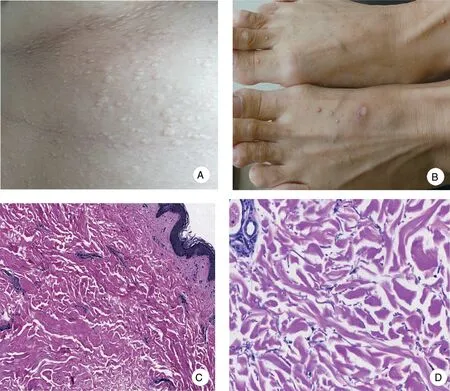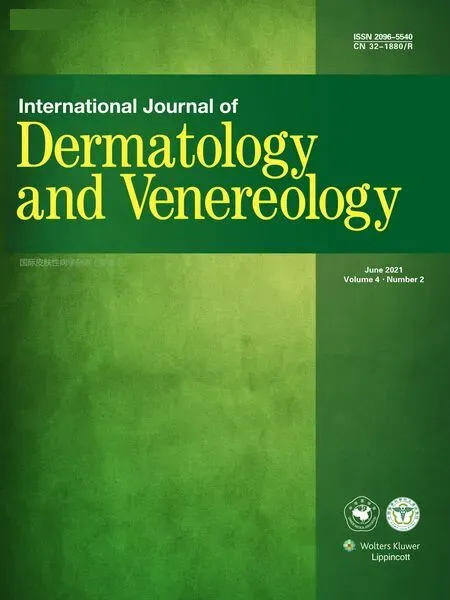Eruptive Cutaneous Collagenoma:Report of Two Cases
Jian Wu,Mei-Hong Cai,Ling-Ling Chen,Lei Wu,Xiao-Jian Chen,Hong-Yan Zhu,Feng Shi*
Department of Dermatology and Venereology,Suzhou Municipal Hospital,Suzhou,Jiangsu 215008,China.
Abstract Introduction:Eruptive cutaneous collagenoma is non familial connective tissue nevi of unknown etiology presented with an abrupt onset.To date,the literatures on eruptive cutaneous collagenoma are extremely rare in china.Here,we report two women with eruptive cutaneous collagenoma.
Keywords:case report,eruptive cutaneous collagenoma,chinese women,trunk and extremities
Introduction
Eruptive cutaneous collagenoma is connective tissue nevi of unknown etiology presented with an abrupt onset.1The lesions are always characterized by multiple asymptomatic,papules,plaques,and nodules without history of illness in adolescence.Histopathologically,the lesions are characterized by dense,coarse collagen fibers in the dermis.There is no familial occurrence.The report on eruptive cutaneous collagenoma is extremely rare in China.To date,there was just one report about eruptive cutaneous collagenoma in a man where the lesions occurred only on back and shoulders.1We hereby describe two cases of eruptive cutaneous collagenoma in two women where the lesions occurred on the trunk and extremities.
Case report
Case 1,a 37-year-old woman presented with a 15-year history of multiple asymptomatic,skin-colored papules and nodules on the trunk and extremities.The first lesions appeared on the waist 15 years ago,then the rashes increased slowly and spread gradually to the chest,abdomen,and extremities.The patient denied history of previous illness or injury at the areas,where the lesions developed.There was no familial occurrence.The dermatological examination revealed multiple,skincolored,firm,oval papules,and nodules on the trunk and extremities,and the lesions were more serious on the trunk(Fig.1A).There were no significant changes in blood routine,urine routine,feces routine,blood sugar,blood lipid,liver function,renal function,and thyroid function.Radio-examination showed no skeletal abnormalities.Histopathology revealed dense,coarse collagen fibers and decreased,fragmented elastic fibers(Fig.1C and 1D)compared with normal skin.Therefore,we made the diagnosis based on these findings.Unfortunately,no specific treatment was given.After 3 years of follow-up,no significant changes in the patient’s rashes.Agreement for the case publication was obtained from the patient.

Figure 1.Clinical and histopathological findings of the patients with eruptive cutaneous collagenoma.(A and B)Firm,skin-colored papules and nodules on the trunk(A:case 1;B:case 2).(C)Histopathological results showed dense,coarse collagen bundles in the dermis(H&E staining,×40).(D)Decreased,fragmented elastic fibers in the dermis(Elastic stain,×200).
Case 2,a 32-year-old female presented with multiple light color papules on the trunk and extremities of unknown etiology 3 years ago.The first lesions appeared on the instep with the size as a rice,and then the rashes increased slowly and spread gradually to the trunk,legs,and upper limbs without any therapy.The patient had no history of previous illness or injury.There was no familial occurrence.The dermatological examination revealed hundreds scattered light,oval,clear boundary,and hard papules on the trunk and extremities as the size like a rice to a broad bean,and the lesions were more serious on the back and feet(Fig.1B).Blood routine,urine routine,feces routine,blood sugar,blood lipid,liver function,renal function,and thyroid function were within normal limits.Histopathology revealed dense,coarse collagen fibers and decreased,fragmented elastic fibers.Based on these findings,the diagnosis of eruptive cutaneous collagenoma was made.Unfortunately,no specific treatment was given.After 2 years of follow-up,no significant changes in the patient’s rashes.Agreement for the case publication was obtained from the patient.
Discussion
Collagenomas are considered to be connective tissue nevi composed predominantly of collagen.They have been classified by Uitto et al.on the basis of the patterns of distribution(localized or generalized)and mode of inheritance(acquired or inherited).2While the acquired collagenomas include eruptive collagenomas and isolated collagenomas,those that are inherited are familial cutaneous collagenomas and Shagreen patches of tuberous sclerosis.There are also reports that collagenomas is associated with other systemic diseases,such as cardiomyopathy,hypogonadism,pseudohypoparathyroidism,Down syndrome,and multiple endocrine neoplasia type I.
Eruptive cutaneous collagenoma presents with discrete firm skin-colored papules,nodules or plaques of various sizes on the trunk and upper extremities in the first two decades of life.Histopathologically,the lesions are characterized by an excessive accumulation of randomly arranged coarse collagen fibers with either reduced,altered,or absent elastic tissue.
Eruptive cutaneous collagenoma should be differentiated from other kinds of skin collagenoma,as well as white fibrous papulosis of the neck,Buschke-Ollendroff syndrome,anetoderma of Schweninger-Buzzi,and Papular elastorrhexis.3
Familial cutaneous collagenoma is an autosomal dominated disorder,first reported in 1968 and characterized by clinical characteristics similar to eruptive cutaneous collagenoma.However,there is distinct family history and associated systemic involvement.Shagreen path is always seen in patients with Tuberous sclerosis,characterized by single to few dis-symmetrically distributed skincolored plaques of various size mainly in the lumbosacral region.4Isolated collagenomas are solitarily acquired collagenomas localized to one part of body and not related to any disease.They can present as particular type of lesions,such as plantar collagenoma,paving stone naevi,zosteriform lesions,and papulolinear lesions.5
White fibrous papules of the neck usually appear in elderly patients and always can be seen on the neck with non-confusion papules.Buschke-Ollendroff syndrome is an autosomal dominated disorder with symptoms of osteopoikilosis,characterized by single or few disseminated skin-colored,white or yellow papules,plaques,or nodules on the trunk and limbs.3Histopathologically,collagen bundles are thickened,homogenized and the jelastic fibers are not increased but are coarse and clumped.5Schweninger-Buzzi anetoderma has some clinical similarities with eruptive cutaneous collagenoma,but it is obviously characterized by herniation phenomenon of lesions.The lesions of Schweninger-Buzzi anetoderma are softly atrophic plaques,and mildly protrude from the skin.When palpating,the resistance is less than that of the surrounding skin,producing signs of“button hole”.Kuwatsuka et al.6proposed the new name“eruptive papular collageno-elastopathy”to unify the two indistinguishable entities,eruptive collagenoma,and papular elastorrhexis,because of the similar clinicopathology.The two patients were diagnosed with eruptive cutaneous collagenoma based on the symptoms of multiple lesions,histopathological findings,the lack of family history,and systemic findings.Since the disease has no family history or other systemic diseases,it has a high rate of misdiagnosis.
An extensive review of Chinese literature has yielded a paucity of case reports of eruptive cutaneous collagenoma.Although these entities are relatively uncommon,a degree of suspicion and a good clinical acumen contribute to diagnosis of such cases which can be confirmed by histopathology.
In conclusions,we present two extremely rare cases of eruptive cutaneous collagenoma that provide more practical experience for clinical evidence-based medicine.As far as we know,no previous study has investigated the report of eruptive cutaneous collagenoma in two Chinese women.Unfortunately,the pathogenesis of eruptive cutaneous collagenomas is unclear,and also no efficient treatment is available.
Source of funding
This work was supported by the Youth Science and technology project in science and education of Suzhou(KJXW2016026).
Acknowledgment
The authors would like to thank Xue-Si Zeng for his expert technical assistance and helpful comments.
- 国际皮肤性病学杂志的其它文章
- The Power of Molecular Genetics in Understanding Heritable Skin Disorders:Introduction to the Special Theme on Genodermatosis
- Piloleiomyoma
- Urethral Orifice Genital Herpes Caused by HSV-1 in a Female Patient:A Case Report
- Clinical Manifestations of Adult Langerhans Cell Histiocytosis with Multisystem Involvement Successfully Treated Using Chemotherapy
- The Association of Psoriasis and Obesity:Focusing on IL-17A-Related Immunological Mechanisms
- Resveratrol Inhibits Secretion of Interleukin 8 by Regulation of Autophagic Flux in Ultraviolet B-stimulated Keratinocytes

